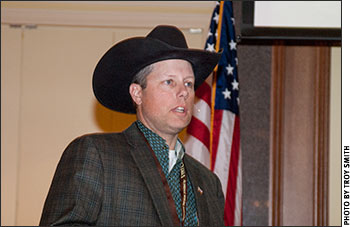The Route to Higher Premiums
S.D. Angus producer shares journey to producing and marketing better cattle.
When Faulkton, S.D., cattleman Troy Hadrick and his two cousins took over management as the fifth generation on their family farming operation in 2012, the trio viewed it as an opportunity to revisit their goals and set new ones. Facing the combination of drought and corn costs at record highs that year, Hadrick shared that growing their commercial herd size to try to increase profits wasn’t a viable option.
“We decided to focus on making our cattle better to make them more valuable,” he said.

“We always think it’s slow to make genetic change, but I don’t think it is if you use the technology available and make decisions based on them,” Troy Hadrick told the RBCS audience.
Hadrick detailed his genetic improvement journey with their commercial cow herd during the past five years at the 25th Range Beef Cow Symposium (RBCS) Nov. 28 in Cheyenne, Wyo. The RBCS is a biennial event cohosted by the University of Wyoming, Colorado State University, the University of Nebraska and South Dakota State University.
Hadrick noted that his family’s previous goals were typical of many commercial operations: grow big calves, keep the biggest replacement heifers and market once per year through the sale barn. Their list of new goals included: shortening the calving season, reducing cow size, improving pasture management, and utilizing technology to make cattle more valuable and then marketing accordingly.
To that end, in 2012 every cow on the operation was bred by artificial insemination (AI) to superior sires. Cleanup bulls from known pedigrees were used after the AI season. The 2013 calf crop from the AI sires was then retained through the feedlot and finishing phase to gather carcass data. Calves from cleanup sires were sold at the sale barn. When Hadrick got that data back in June 2014, the retained ownership cattle made money — because the market was good — but Hadrick says the data showed his cattle were average.
He was also frustrated by the time lag.
“It was a good start [getting the data], but it took 26 months from breeding until we got the carcass data,” he said. “We’d already made decisions for two more breeding seasons.”
In 2014, Hadrick decided to use the GeneMax® Focus™ genetic test (offered by Zoetis) on his entire steer crop before the steers left the farm. The results, he said, provided the performance benchmark and confidence to retain ownership on all of their calves. He was pleased that genomic testing whittled the window for getting information back down to a mere 11 months. They’ve since begun genomic testing their heifers and bulls, as well.
From 2014 to 2017, they’ve moved from no Prime cattle to 35% Prime. In that time span, they’ve gone from about 32% qualifying for the Certified Angus Beef® (CAB®) brand to 82% CAB.
“My goal is to reach 100% CAB because you get a premium for every single pound,” Hadrick said.
“We always think it’s slow to make genetic change, but I don’t think it is if you use the technology available and make decisions based on them,” Hadrick told the RBCS audience.
Hadrick admitted that, like anything, change brings challenges. He noted that one of the biggest obstacles was simply convincing himself — and his family — to make the change, stick to the plan and use the data. He cited interpreting the data, especially that first year; managing the data; and finding a feedyard to work with, as well as a grid and packing plant, among the challenges. However, additional premiums today near $100 per head back to the family operation have made it worthwhile.
Hadrick concluded: “I thought it would take 10 to 15 years to improve our genetics. We got there in four to five years. There’s no magical sauce. … It’s just using the tools available to every one of us in this room to make cattle more valuable.” By bringing that value to their operation, Hadrick said he is hopeful to be in a position to eventually pass their operation on to the sixth generation.

Editor’s Note: Kindra Gordon is a cattlewoman and freelance writer from Whitewood, S.D. This summary was written under contract or by staff of the Angus Journal, which retains the copyright, as part of Angus Media’s online coverage of the event. To request to reprint this article, contact the editor at 816-383-5200. For full online coverage, including PowerPoints, proceedings and audio of presentations, visit the Newsroom at www.rangebeefcow.com. The Angus Journal's coverage of the event is made possible through collaboration with the event committee.






